TSU Permanent Collection 2D Items
Item set
- Title
- TSU Permanent Collection 2D Items
- Description
- 2D items within the permanent art collection of Texas Southern University, includes student work and Hannah Hall murals
- Creator
- Various TSU student and professors, as well as outside artists
- Date Created
- 1950 - present
- Has Part
-
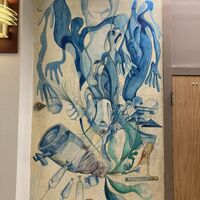 TSU Hannah Hall Murals
TSU Hannah Hall Murals
-
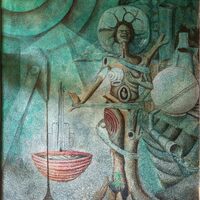 Hannah Hall 1st Floor Murals
Hannah Hall 1st Floor Murals
-
 Hannah Hall 2nd Floor Murals
Hannah Hall 2nd Floor Murals
-
 Hannah Hall 3rd Floor Murals
Hannah Hall 3rd Floor Murals
- Is Part Of
-
 TSU Permanent Collection
TSU Permanent Collection
Items
-
 [unknown] similar style to #44, textured bodies, everything is fluid and in motion, yin and yang on top and opening on bottom - heavy damage (left of staircase when walking up stairs
[unknown] similar style to #44, textured bodies, everything is fluid and in motion, yin and yang on top and opening on bottom - heavy damage (left of staircase when walking up stairs -
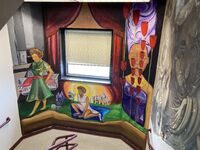 [unknown] three black female figures, flowers and picnic blanket, city scene and car, old woman in headwrap (ancestor?), curtains around opening of stair window - no damage
[unknown] three black female figures, flowers and picnic blanket, city scene and car, old woman in headwrap (ancestor?), curtains around opening of stair window - no damage -
 [unknown] Tiger Walk in front Sterling Student Life Center, use of bright colors, there are trees with fraternity and sorority symbols painted on them, Greek life mascots - water damage
[unknown] Tiger Walk in front Sterling Student Life Center, use of bright colors, there are trees with fraternity and sorority symbols painted on them, Greek life mascots - water damage -
 [unknown] tree people/nature scene, colorful plants that are morphing into faces, unfinished (side of staircase when ascending up stairs) - unfinished
[unknown] tree people/nature scene, colorful plants that are morphing into faces, unfinished (side of staircase when ascending up stairs) - unfinished -
 [unknown] Black Jesus, some biblical scenes, Exodus, pouring down water to community - no damage
[unknown] Black Jesus, some biblical scenes, Exodus, pouring down water to community - no damage -
 [unknown] four men, learning and science, sun and star coming through, animals/farm in background - some damage and graffiti
[unknown] four men, learning and science, sun and star coming through, animals/farm in background - some damage and graffiti -
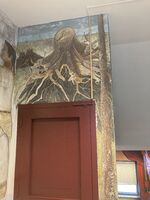 [unknown] trees are now chopped down, separated from 42a by mural #43 (damaged)
[unknown] trees are now chopped down, separated from 42a by mural #43 (damaged) -
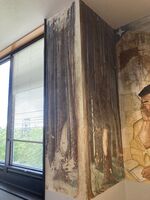 [unknown] forest with light coming from left - heavy damage (possibly unfinished)
[unknown] forest with light coming from left - heavy damage (possibly unfinished) -
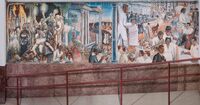 The History of the Negro in Education Washington’s mural shows a timeline of Black education from left to right. On the left side of the mural, he depicts slavery and lynching above enslaved people secretly reading. In the center, girls write “Emancipation Proclamation;” next, Booker T. Washington delivers his "Atlanta Compromise" speech. The right shows emerging Black professionals.
The History of the Negro in Education Washington’s mural shows a timeline of Black education from left to right. On the left side of the mural, he depicts slavery and lynching above enslaved people secretly reading. In the center, girls write “Emancipation Proclamation;” next, Booker T. Washington delivers his "Atlanta Compromise" speech. The right shows emerging Black professionals. -
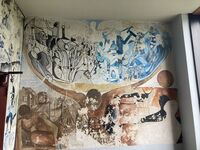 [unknown] nightlife scene, worship, longhorn, two houses, two prominent male figures - (right of doorway when ascending stairs) heavy damage
[unknown] nightlife scene, worship, longhorn, two houses, two prominent male figures - (right of doorway when ascending stairs) heavy damage -
 [unknown] McCowan’s mural portrays the brutality of war in the mid-twentieth century. Cold War-era themes of scientific and technological competition and atomic weapon fears appear. Inspired by Dr. Biggers’ philosophy of mural painting, McCowan integrates the wall’s architectural elements (a fire hose and extinguisher) to highlight the tension of the scene.
[unknown] McCowan’s mural portrays the brutality of war in the mid-twentieth century. Cold War-era themes of scientific and technological competition and atomic weapon fears appear. Inspired by Dr. Biggers’ philosophy of mural painting, McCowan integrates the wall’s architectural elements (a fire hose and extinguisher) to highlight the tension of the scene. -
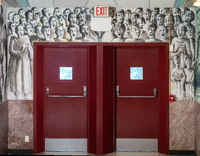 [unknown] Hatter’s mural shows a full church choir of men, women, and children singing passionately. Hatter chose this location for his mural to make use of the arching shape of the doorway, similar to the arrangement of a choir standing on risers. The white panel in the middle is where the exit sign once was located; Hatter used it as a lamp in the design.
[unknown] Hatter’s mural shows a full church choir of men, women, and children singing passionately. Hatter chose this location for his mural to make use of the arching shape of the doorway, similar to the arrangement of a choir standing on risers. The white panel in the middle is where the exit sign once was located; Hatter used it as a lamp in the design. -
 [unknown] McNeil’s mural depicts Christian themes. Christian iconography of the cross, lamb, wine, and dove appear in the composition. The design subverts classical Christian art by inserting everyday Black people in stained-glass style, instead of highly stylized, white saints. McNeil took pride in painting the first cross in Hannah Hall.
[unknown] McNeil’s mural depicts Christian themes. Christian iconography of the cross, lamb, wine, and dove appear in the composition. The design subverts classical Christian art by inserting everyday Black people in stained-glass style, instead of highly stylized, white saints. McNeil took pride in painting the first cross in Hannah Hall. -
 [unknown] children on a bridge - damaged (above the stairs on entrance to 3rd floor)
[unknown] children on a bridge - damaged (above the stairs on entrance to 3rd floor) -
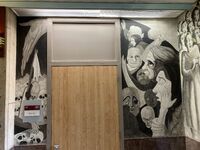 [unknown] greyscale, pile of skulls, white flag, several faces/mask, outstretched hand (separated by door) - no damage
[unknown] greyscale, pile of skulls, white flag, several faces/mask, outstretched hand (separated by door) - no damage -
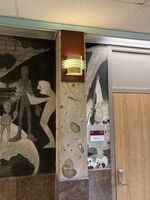 [unknown] painted on column, looks like bedrock or fossils
[unknown] painted on column, looks like bedrock or fossils -
 [unknown] greyscale, morbid, includes guns firing, injured people, sword and people crying out - no damage
[unknown] greyscale, morbid, includes guns firing, injured people, sword and people crying out - no damage -
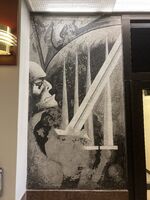 [unknown] uses greyscale, facial figure, some angular structures, skull in corner - damaged
[unknown] uses greyscale, facial figure, some angular structures, skull in corner - damaged -
 [unknown] Cleinmann's mural reflects the past, present, and future, with an emphasis on the importance of Black women. This is a manifestation of Dr. Biggers’ teachings. This mural is one of few unfinished murals left standing in Hannah Hall; typically, unfinished murals would be painted over to allow another student to decorate the wall.
[unknown] Cleinmann's mural reflects the past, present, and future, with an emphasis on the importance of Black women. This is a manifestation of Dr. Biggers’ teachings. This mural is one of few unfinished murals left standing in Hannah Hall; typically, unfinished murals would be painted over to allow another student to decorate the wall. -
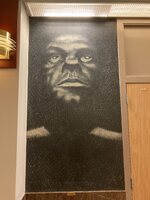 [unknown] Across two panels, separated by a mural, Oliver’s mural uses crosshatched, dark green hues to depict a woman and child (together) and a man (separate). Almost all art students painted only one mural; Oliver was an exception. Because of his enthusiasm and talent, he painted several murals, often using small spaces between other students’ works.
[unknown] Across two panels, separated by a mural, Oliver’s mural uses crosshatched, dark green hues to depict a woman and child (together) and a man (separate). Almost all art students painted only one mural; Oliver was an exception. Because of his enthusiasm and talent, he painted several murals, often using small spaces between other students’ works. -
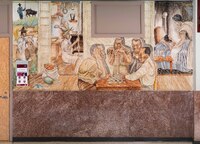 [unknown] Ross' mural captures a snapshot of Black rural life in the twentieth century. Outside, two men are ranching, while others play checkers on the porch. Inside, one woman is cooking in the kitchen while another cares for a child in bed. The composition also highlights the gendered division of labor, and how women’s work is often pushed to the margins.
[unknown] Ross' mural captures a snapshot of Black rural life in the twentieth century. Outside, two men are ranching, while others play checkers on the porch. Inside, one woman is cooking in the kitchen while another cares for a child in bed. The composition also highlights the gendered division of labor, and how women’s work is often pushed to the margins. -
 [unknown] Across two panels, separated by a mural, Oliver’s mural uses crosshatched, dark green hues to depict a woman and child (together) and a man (separate). Almost all art students painted only one mural; Oliver was an exception. Because of his enthusiasm and talent, he painted several murals, often using small spaces between other students’ works.
[unknown] Across two panels, separated by a mural, Oliver’s mural uses crosshatched, dark green hues to depict a woman and child (together) and a man (separate). Almost all art students painted only one mural; Oliver was an exception. Because of his enthusiasm and talent, he painted several murals, often using small spaces between other students’ works. -
 Evolution many figures, some are faceless, use of cross hatching - damaged (left when ascending stairs)
Evolution many figures, some are faceless, use of cross hatching - damaged (left when ascending stairs) -
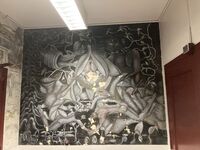 [unknown] romance, trees/roots, blue and dark hues - damaged paint chipping (right when ascending stairs)
[unknown] romance, trees/roots, blue and dark hues - damaged paint chipping (right when ascending stairs) -
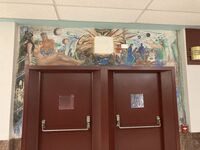 [unknown] creation, planets, Adam and Eve - damaged (interior above staircase doors)
[unknown] creation, planets, Adam and Eve - damaged (interior above staircase doors)